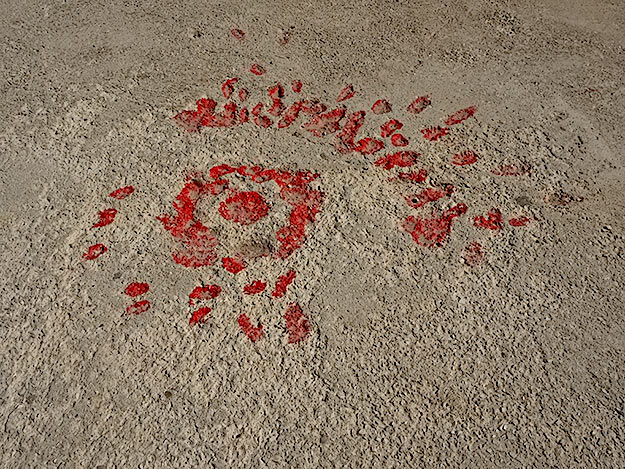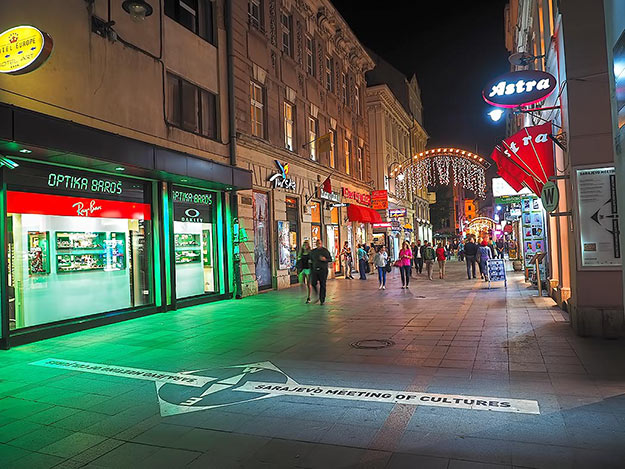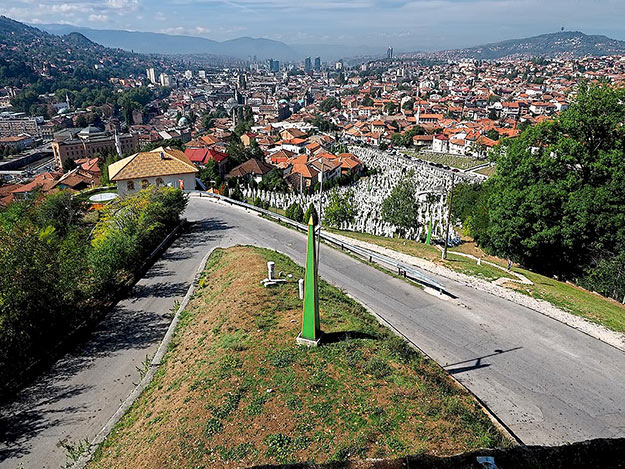I trampled a few roses before learning why the streets and sidewalks of Sarajevo were covered with red splotches. During the Bosnian War, an average of 329 mortar shells rained down on the city every day for more than 3.5 years, leaving a moonscape of craters. After the war ended in 1995, these holes were filled with red resin. With the unique sense of humor that had allowed Sarajevans to survive the longest siege in the history of modern warfare, residents of the city dubbed these floral-shaped memorials Sarajevo Roses. Once I knew the story, I trod more respectfully.

The Bosnian War erupted as a result of the breakup of the former Yugoslavia. Unlike ethnically homogeneous regions such as Slovenia and Croatia, both of which had successfully seceded from Yugoslavia by 1991, Bosnia-Herzegovina was home to Catholic Croats, Orthodox Christian Serbs, and Bosnian Moslems. Bosnia’s declaration of independence in 1992 infuriated Bosnian Serbs, who preferred to maintain allegiance with neighboring Serbia. On April 6, 1992, with the support of military forces from Serbia, they began seizing areas of Bosnia predominantly occupied by ethnic Serbs.
For the next 1,425 days, Serbs bombarded the city from surrounding mountaintops, killing more than 11,500 people, including 1,601 children. Inside the city, Serbian snipers took up positions in high rise buildings, shooting anyone who ventured into the open. Yet Sarajevans refused to capitulate. In the safest neighborhoods, primary and secondary schools were set up in basements and garages. The University of Sarajevo continued to operate in same way. Rock concerts were held in shelters. Actors from Sarajevo’s three theaters, all of which had ceased to operate due to the war, founded the Sarajevo War Theater and put on 2,000 underground performances during the siege. Even Sarajevo’s film festival, today the fourth largest in Europe, was founded during the siege. Someone got a copy of Pulp Fiction and everyone wanted to watch it, so a camera was found and the film was shown in a sandbag-protected basement.
Through it all, Sarajevans did not lose their sense of humor. When Serbs scribbled “This is Serbia” on the Post Office walls, Bosnians wrote beneath it, “No stupid, this is the Post Office.” Graffiti-covered street signs carried the cryptic message: “Run or RIP.” To stave off starvation, residents ate rank ICAR canned beef rations provided by the United Nations, some of which dated back to the Vietnam War and was 20 years past its expiration date. It stank so badly that all the windows in a room had to be opened before popping a can. After the war, Sarajevans erected an oversize sculpture of a can of beef with the sarcastic inscription, “To the international community, the grateful citizens of Sarajevo.”

The war ended on December 14, 1995, following an intervention by NATO forces. Twenty years on, Sarajevo is once again a cosmopolitan capital city, where mosques and cathedrals coexist and people of all cultures mingle. In the Bašcaršija, (the old Ottoman Bazaar), a sign painted on the pavement proudly proclaims, “Sarajevo, Meeting of Cultures.” The sound of gunfire and grenades has been replaced by the hammering of copper smiths and the tinkling of glasses as Bosnians sip tiny cups of their smooth, rich coffee. Unlike the city of Mostar in the southern part of Bosnia, where schools are segregated according to ethnicity and religion, Sarajevo’s schools are integrated. The National Library has been restored, museums have opened all over town, and tourists are returning.

But left-over effects of the war are still visible for those who look closely. Unable to safely reach cemeteries during the war, the dead were buried in parks, squares, and even in the sports complex that was constructed for the 1984 Winter Olympics. From the hilltop upon which the Yellow Fort perches, the view is punctuated by row upon row of white crosses that stretch for acres. All of Sarajevo’s electric tram cars were destroyed during the war, so cities around world donated their old cars. Blue ones are 1970 vintage from Prague and red coaches with old wooden benches hail from 19th century Vienna. Many of the thousands of buildings that incurred severe damage still display bullet-riddled exteriors.

Some artifacts from the war have been turned into tourist attractions. The Sarajevo War Tunnel, which has been credited with saving Sarajevans from starvation, is the highlight of a Sarajevo Under the Siege tour. Dug beneath the runway of the airport, it connected the city with the only Bosnian-held hill in an otherwise Serb-surrounded valley. I walked through a small portion of the tunnel that has been preserved. Even with bright lighting and drainage that now keeps it from flooding, the experience was suffocating. I couldn’t even imagine slogging through mud and knee-high water, bent nearly double in the cramped passage, with an 80-pound pack of food and weapons on my back.

Today Bosnia-Herzegovina presents a peaceful exterior to the world, but tensions lie just beneath the surface. In a bid to pursue membership in the European Union, Bosnia conducted its first census since the war in 2013. However, the inclusion of non-mandatory questions about ethnicity and mother tongue rankled many. Dino Bazdarevic, my guide on the Sarajevo Under the Siege tour, explained that respondents were given a choice of four possible ethnicities: Serb, Croat, Bosniak (Muslim), or other. “I am an other,” he insisted. “I refused to declare myself as a Bosniak because I don’t think my religion should be mixed with my ethnicity, so I wrote Bosnian on the line for other. Perhaps half of the young people did the same, and they cannot have a constitution that does not represent half of the population.”
More than two years after the completion of the census, results have still not been released and conspiracy theories abound. The questions relating to language and ethnicity were not a requirement of the E.U.; they were added by politicians who insisted that without this data, one ethnic group might end up dominating and marginalizing the others. Which brings me back to the Sarajevo Roses. Henry David Thoreau said, “Truths and roses have thorns about them.” I can’t think of a more appropriate symbol for Sarajevo.

Laughing so hard at the Post Office comment which yes, is very typical of the region’s humor. Bless Sarajevo – brave, resilient people. <3
Hi Kate: It was definitely one of the most interesting regions of the world that I’ve ever visited. It still amazes me that residents of Sarajevo and Mostar were able to survive during more than three years of such intense fighting.